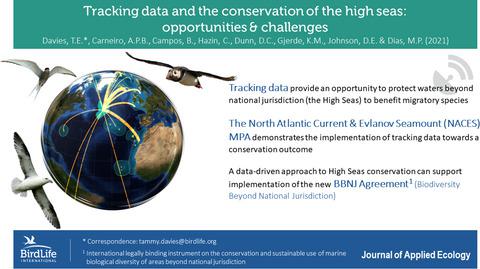当前位置:
X-MOL 学术
›
J. Appl. Ecol.
›
论文详情
Our official English website, www.x-mol.net, welcomes your feedback! (Note: you will need to create a separate account there.)
Tracking data and the conservation of the high seas: Opportunities and challenges
Journal of Applied Ecology ( IF 5.7 ) Pub Date : 2021-09-18 , DOI: 10.1111/1365-2664.14032 Tammy E. Davies 1 , Ana P. B. Carneiro 1 , Bruna Campos 2 , Carolina Hazin 1 , Daniel C. Dunn 3 , Kristina M. Gjerde 4 , David E. Johnson 5 , Maria P. Dias 1, 6
中文翻译:

跟踪数据和保护公海:机遇和挑战
更新日期:2021-09-18
Journal of Applied Ecology ( IF 5.7 ) Pub Date : 2021-09-18 , DOI: 10.1111/1365-2664.14032 Tammy E. Davies 1 , Ana P. B. Carneiro 1 , Bruna Campos 2 , Carolina Hazin 1 , Daniel C. Dunn 3 , Kristina M. Gjerde 4 , David E. Johnson 5 , Maria P. Dias 1, 6
Affiliation

|
- Biologging technology is rapidly advancing—scientists are obtaining data on movement and behaviour for a range of species, more accurately than ever before. With this information, it is possible to understand more about important areas and their connections across the open ocean including the high seas, beyond national jurisdictions. But an absence of a global governance framework has so far hindered a coordinated approach to conservation action on the high seas.
- We showcase a candidate high seas MPA in the Northeast Atlantic identified primarily from seabird tracking data and being taken forward under a regional process: the North Atlantic Current and Evlanov Seamount (NACES) MPA, under the OSPAR Commission. It provides a unique case study to learn about the intricacies of implementation when applying tracking information for conservation. From this, we identify the facilitating conditions and challenges faced from identification to designation and highlight actionable opportunities for future area-based management of the high seas that will be made possible under a new agreement.
- Policy implications. The North Atlantic Current and Evlanov Seamount (NACES) MPA demonstrates the power of translating tracking data into usable geospatial knowledge to inform conservation and policy and provides an exemplar for a data-driven approach to high seas conservation that can become a reality under the forthcoming governance framework (under the United Nations Convention on the Law of the Sea on the conservation and sustainable use of marine biological diversity of areas beyond national jurisdiction (known as the BBNJ Agreement)). This new agreement presents a unique conservation opportunity both for the application of tracking data to conservation outcomes and for the protection of migratory species.
中文翻译:

跟踪数据和保护公海:机遇和挑战
- 生物记录技术正在迅速发展——科学家们正在以比以往任何时候都更准确的方式获取一系列物种的运动和行为数据。有了这些信息,就可以更多地了解国家管辖范围以外的重要区域及其跨越公海(包括公海)的联系。但迄今为止,缺乏全球治理框架阻碍了在公海采取协调一致的保护行动。
- 我们展示了东北大西洋的一个候选公海 MPA,该 MPA 主要从海鸟跟踪数据中确定,并在区域进程下推进:OSPAR 委员会下的北大西洋洋流和埃夫拉诺夫海山 (NACES) MPA。它提供了一个独特的案例研究,以了解在应用跟踪信息进行保护时实施的复杂性。由此,我们确定了从识别到指定所面临的便利条件和挑战,并强调了根据新协议将成为可能的未来公海区域管理的可行机会。
- 政策影响。北大西洋海流和埃夫拉诺夫海山 (NACES) MPA 展示了将跟踪数据转化为可用的地理空间知识来为保护和政策提供信息的能力,并为公海保护的数据驱动方法提供了一个范例,该方法可以在即将到来的治理下成为现实框架(根据《联合国海洋法公约》关于国家管辖范围以外区域海洋生物多样性的养护和可持续利用(称为 BBNJ 协定))。这项新协议为将跟踪数据应用于保护结果和保护迁徙物种提供了独特的保护机会。



























 京公网安备 11010802027423号
京公网安备 11010802027423号